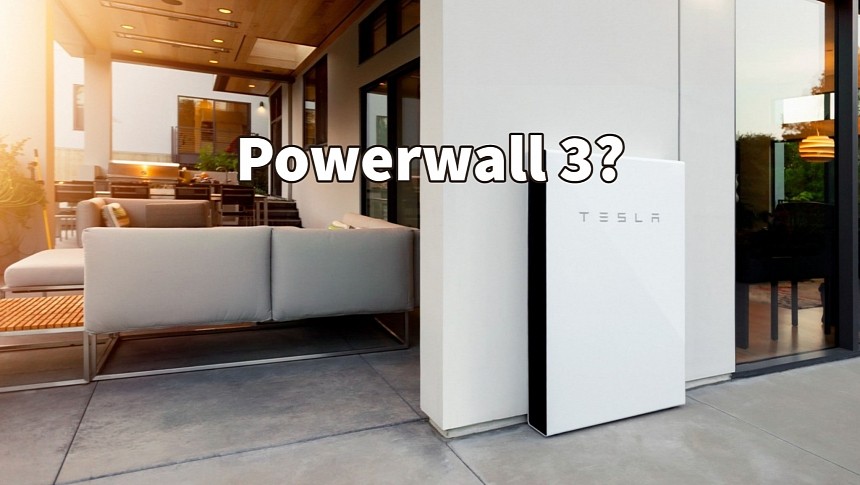Tesla is preparing the launch of its next-generation home battery storage system. The Powerwall 3 will offer a meaningful upgrade over the current generation, with a switch to LFP cells and increased power output. A new report confirms previous rumors and provides the first information about Powerwall 3's power output.
Tesla Energy earlier teased Powerwall 3, saying the team is working on a system that would offer easier installation, better aesthetic, and higher performance than before. Insiders were able to confirm some details, and they were pretty juicy. The most significant change coming with the third-generation Powerwall was the switch to using prismatic lithium-iron-phosphate (LFP) battery cells instead of the current cylindrical nickel-manganese-cobalt (NMC) cells.
The Powerwall 3 home battery system has already been certified by several US electric utilities, as we reported last month. This also allowed the media to confirm some of the Powerwall 3 specifications. If our sources were right, the battery storage system should stick with the current 13.5-kWh capacity, despite having a smaller enclosure. This was intriguing, considering the switch to LFP cells, which tend to have a lower energy density. Still, the LFP cells have significantly improved energy density over the past years.
The reports also confirmed the peak power output of 15.4 kW, a 50% improvement over the 10 kW peak power offered by the Powerwall 2. Still, considering that the peak power output is specified for 10 seconds, this doesn't tell much about the true capability of the battery pack. Thanks to Electrek, we now know that the Powerwall 3 will be able to sustain an 11.5-kW continuous power output in its most powerful configuration. The Powerwall 2, for instance, maxed out at 5.8 kW, which makes the new model twice as powerful.
If the report is accurate, the Powerwall 3 will be a significant upgrade even for existing projects. Having that much power changes the economics because fewer modules will be needed. Most current Tesla Powerwall deployments have more than one module installed because the power requirements surpassed the capacity of the Powerwall 2 system. Also, the higher power output means the system can send more power into the grid when the rates are higher, maximizing profitability.
As the Li-ion cell production yields improve, Tesla can divert more cells from the EV production lines to its energy business. Until recently, Tesla only sold Powerwall systems to people who would also install solar panels or solar roofs. Now, Tesla is confident it can access enough cells to sell Powerwall even without the solar part. This is still a robust backup solution for on-grid applications, offering relief during power outages. The Powerwall system can also draw energy from the grid when it's cheaper and inject it back when the rates are higher.
The Powerwall 3 home battery system has already been certified by several US electric utilities, as we reported last month. This also allowed the media to confirm some of the Powerwall 3 specifications. If our sources were right, the battery storage system should stick with the current 13.5-kWh capacity, despite having a smaller enclosure. This was intriguing, considering the switch to LFP cells, which tend to have a lower energy density. Still, the LFP cells have significantly improved energy density over the past years.
The reports also confirmed the peak power output of 15.4 kW, a 50% improvement over the 10 kW peak power offered by the Powerwall 2. Still, considering that the peak power output is specified for 10 seconds, this doesn't tell much about the true capability of the battery pack. Thanks to Electrek, we now know that the Powerwall 3 will be able to sustain an 11.5-kW continuous power output in its most powerful configuration. The Powerwall 2, for instance, maxed out at 5.8 kW, which makes the new model twice as powerful.
If the report is accurate, the Powerwall 3 will be a significant upgrade even for existing projects. Having that much power changes the economics because fewer modules will be needed. Most current Tesla Powerwall deployments have more than one module installed because the power requirements surpassed the capacity of the Powerwall 2 system. Also, the higher power output means the system can send more power into the grid when the rates are higher, maximizing profitability.
As the Li-ion cell production yields improve, Tesla can divert more cells from the EV production lines to its energy business. Until recently, Tesla only sold Powerwall systems to people who would also install solar panels or solar roofs. Now, Tesla is confident it can access enough cells to sell Powerwall even without the solar part. This is still a robust backup solution for on-grid applications, offering relief during power outages. The Powerwall system can also draw energy from the grid when it's cheaper and inject it back when the rates are higher.











